Aston University: Difference between revisions
No edit summary Tag: gettingstarted edit |
No edit summary Tag: gettingstarted edit |
||
| Line 35: | Line 35: | ||
The origins of Aston University are a School of Metallurgy formed in the [[Birmingham and Midland Institute]] in 1875. The Birmingham Municipal Technical School separated from the Institute in 1895, teaching chemistry, physics, metallurgy and electrical engineering.<ref name="History and Traditions">{{cite web|url=http://www1.aston.ac.uk/about/history/|title=History and Traditions|year=2008|publisher=Aston University|accessdate=2008-12-31| archiveurl= http://web.archive.org/web/20081219025224/http://www1.aston.ac.uk/about/history/| archivedate= 19 December 2008 <!--DASHBot-->| deadurl= no}}</ref> The school changed its name in 1927 to the Birmingham Central Technical College,<ref name="History and Traditions" /> to reflect its changing approach to teaching technology. |
The origins of Aston University are a School of Metallurgy formed in the [[Birmingham and Midland Institute]] in 1875. The Birmingham Municipal Technical School separated from the Institute in 1895, teaching chemistry, physics, metallurgy and electrical engineering.<ref name="History and Traditions">{{cite web|url=http://www1.aston.ac.uk/about/history/|title=History and Traditions|year=2008|publisher=Aston University|accessdate=2008-12-31| archiveurl= http://web.archive.org/web/20081219025224/http://www1.aston.ac.uk/about/history/| archivedate= 19 December 2008 <!--DASHBot-->| deadurl= no}}</ref> The school changed its name in 1927 to the Birmingham Central Technical College,<ref name="History and Traditions" /> to reflect its changing approach to teaching technology. |
||
In 1951, the Technical College was renamed the ''College of Technology, Birmingham''<ref name="History and Traditions" /> and work began on the Main Building at Gosta Green. In 1956, it became the first elite designated [[College of Advanced Technology (United Kingdom)|College of Advanced Technology]] and underwent a major expansion.<ref name="History and Traditions" /> It moved into buildings that were constructed between 1949 and 1955 to a design by Ashley & Newman. Princess Margaret laid one of the first foundation stones at the base of the new building in 1951. In 1956, the College of Advanced Technology was opened by Her Majesty The Queen.<ref>{{cite web|url=http://www.aston.ac.uk/50/history/1950s/ |title=1950s |publisher=Aston.ac.uk |date= |accessdate=2014-04-27}}</ref> The college expanded again to a design by the [[City Architect of Birmingham]] [[Alwyn Sheppard Fidler]] between 1957 and 1965.<ref>{{cite book |last= Foster |first=Andy |title=Birmingham |series=Pevsner Architectural Guides |origyear=2005 |year=2007 |page=195 |publisher=Yale University Press |isbn=978-0-300-10731-9}}</ref> |
In 1951, the Technical College was renamed the ''College of Technology, Birmingham''<ref name="History and Traditions" /> and work began on the Main Building at Gosta Green. In 1956, it became the first elite designated [[College of Advanced Technology (United Kingdom)|College of Advanced Technology]] and underwent a major expansion.<ref name="History and Traditions" /> It moved into buildings that were constructed between 1949 and 1955 to a design by Ashley & Newman. Princess Margaret laid one of the first foundation stones at the base of the new building in 1951. The building is one of Europe’s largest, freestanding brick buildings.<ref>http://www.midlandsbusinessnews.co.uk/new-era-conference-aston-help-overbury/</ref> In 1956, the College of Advanced Technology was opened by Her Majesty The Queen.<ref>{{cite web|url=http://www.aston.ac.uk/50/history/1950s/ |title=1950s |publisher=Aston.ac.uk |date= |accessdate=2014-04-27}}</ref> The college expanded again to a design by the [[City Architect of Birmingham]] [[Alwyn Sheppard Fidler]] between 1957 and 1965.<ref>{{cite book |last= Foster |first=Andy |title=Birmingham |series=Pevsner Architectural Guides |origyear=2005 |year=2007 |page=195 |publisher=Yale University Press |isbn=978-0-300-10731-9}}</ref> |
||
It officially became the ''University of Aston in Birmingham'' on receipt of its [[Royal Charter]] on 22 April 1966 and the first Chancellor of the University, [[Henry Nelson, 2nd Baron Nelson of Stafford|Lord Nelson of Stafford]], was installed on 10 May.The Charter of the University outlines objectives appropriate to a technological university: "to advance, disseminate and apply learning and knowledge by teaching and research, for the benefit of industry and commerce and of the community generally: and to enable students to obtain the advantage of a university education, and such teaching and research may include periods outside the University in industry or commerce or wherever the University considers proper for the best advancement of its objects." The emphasis given to the sandwich course system, and the maintenance of strong links with industry, arises naturally from the institution’s history. The motto of the University is the same as that of the City of Birmingham – '''Forward'''.<ref>{{cite web|url=http://www.aston.ac.uk/about/history/ |title=History and traditions |publisher=Aston.ac.uk |date= |accessdate=2014-04-27}}</ref> |
It officially became the ''University of Aston in Birmingham'' on receipt of its [[Royal Charter]] on 22 April 1966 and the first Chancellor of the University, [[Henry Nelson, 2nd Baron Nelson of Stafford|Lord Nelson of Stafford]], was installed on 10 May.The Charter of the University outlines objectives appropriate to a technological university: "to advance, disseminate and apply learning and knowledge by teaching and research, for the benefit of industry and commerce and of the community generally: and to enable students to obtain the advantage of a university education, and such teaching and research may include periods outside the University in industry or commerce or wherever the University considers proper for the best advancement of its objects." The emphasis given to the sandwich course system, and the maintenance of strong links with industry, arises naturally from the institution’s history. The motto of the University is the same as that of the City of Birmingham – '''Forward'''.<ref>{{cite web|url=http://www.aston.ac.uk/about/history/ |title=History and traditions |publisher=Aston.ac.uk |date= |accessdate=2014-04-27}}</ref> |
||
[[File:Astonmainbuilding.jpg|thumb|The main building with water sculpture Tipping Triangles by [[Angela Conner]].]] |
[[File:Astonmainbuilding.jpg|thumb|The main building with water sculpture Tipping Triangles by [[Angela Conner]]. The building is one of Europe’s largest, freestanding brick buildings.<ref>http://www.midlandsbusinessnews.co.uk/new-era-conference-aston-help-overbury/</ref>]] |
||
Establishment of the [[Aston Science Park]] and Aston University’s contribution to the city of Birmingham was fully recognised when the area was granted its own postal address “The Aston Triangle” in 1984, emphasising the campus as an official district of Birmingham. The logo of the establishment takes from the shape of the area.<ref>{{cite web|url=http://www.aston.ac.uk/50/history/1980s/ |title=1980s |publisher=Aston.ac.uk |date= |accessdate=2014-04-27}}</ref> |
Establishment of the [[Aston Science Park]] and Aston University’s contribution to the city of Birmingham was fully recognised when the area was granted its own postal address “The Aston Triangle” in 1984, emphasising the campus as an official district of Birmingham. The logo of the establishment takes from the shape of the area.<ref>{{cite web|url=http://www.aston.ac.uk/50/history/1980s/ |title=1980s |publisher=Aston.ac.uk |date= |accessdate=2014-04-27}}</ref> |
||
Revision as of 06:59, 1 August 2014
| File:Aston University Arms.jpg | |||||||||||||||||||||||
| Motto | Forward | ||||||||||||||||||||||
|---|---|---|---|---|---|---|---|---|---|---|---|---|---|---|---|---|---|---|---|---|---|---|---|
| Type | Public | ||||||||||||||||||||||
| Established | 1875 (granted University Status by Royal Charter in 1966)[1] | ||||||||||||||||||||||
| Endowment | £1.9 million[2] | ||||||||||||||||||||||
| Chancellor | Sir John Sunderland | ||||||||||||||||||||||
| Vice-Chancellor | Dame Julia King | ||||||||||||||||||||||
| Students | 11,323[3] | ||||||||||||||||||||||
| Undergraduates | 8,131[4] | ||||||||||||||||||||||
| Postgraduates | 3,192[5] | ||||||||||||||||||||||
| Location | , England, UK 52°29′10″N 1°53′22″W / 52.4860°N 1.8895°W | ||||||||||||||||||||||
| Campus | 60 acres (240,000 m2), urban | ||||||||||||||||||||||
| Colours | Black and Red
| ||||||||||||||||||||||
| Affiliations | Association of Commonwealth Universities CDIO Initiative European University Association Universities UK AACSB | ||||||||||||||||||||||
| Website | www | ||||||||||||||||||||||
 | |||||||||||||||||||||||
Aston University is a public research campus university situated at Gosta Green, in the city centre of Birmingham, England. Aston began as the Birmingham Municipal Technical School in 1895, evolving into the UK’s first elite College of Advanced Technology in 1956.[6] Aston University received its Royal Charter from Queen Elizabeth II on 22 April 1966.[7]
Aston was ranked by QS as the world's 47th best university under 50 years old in 2012[8] and as the world's 51st best university based on employer reputation in 2011.[9] It was ranked 5th in the UK for graduate employability.[10] A survey suggested it is one of the 20 most targeted universities by the UK's top employers.[11] Aston is a pioneer of integrated placement year concept,[12] with more than 70% of Aston students take placement year, the highest percentage in the UK.[13] Aston has performed well in the National Student Survey, with its highest ever score of 89% in 2013.[14]
History
The origins of Aston University are a School of Metallurgy formed in the Birmingham and Midland Institute in 1875. The Birmingham Municipal Technical School separated from the Institute in 1895, teaching chemistry, physics, metallurgy and electrical engineering.[15] The school changed its name in 1927 to the Birmingham Central Technical College,[15] to reflect its changing approach to teaching technology.
In 1951, the Technical College was renamed the College of Technology, Birmingham[15] and work began on the Main Building at Gosta Green. In 1956, it became the first elite designated College of Advanced Technology and underwent a major expansion.[15] It moved into buildings that were constructed between 1949 and 1955 to a design by Ashley & Newman. Princess Margaret laid one of the first foundation stones at the base of the new building in 1951. The building is one of Europe’s largest, freestanding brick buildings.[16] In 1956, the College of Advanced Technology was opened by Her Majesty The Queen.[17] The college expanded again to a design by the City Architect of Birmingham Alwyn Sheppard Fidler between 1957 and 1965.[18]
It officially became the University of Aston in Birmingham on receipt of its Royal Charter on 22 April 1966 and the first Chancellor of the University, Lord Nelson of Stafford, was installed on 10 May.The Charter of the University outlines objectives appropriate to a technological university: "to advance, disseminate and apply learning and knowledge by teaching and research, for the benefit of industry and commerce and of the community generally: and to enable students to obtain the advantage of a university education, and such teaching and research may include periods outside the University in industry or commerce or wherever the University considers proper for the best advancement of its objects." The emphasis given to the sandwich course system, and the maintenance of strong links with industry, arises naturally from the institution’s history. The motto of the University is the same as that of the City of Birmingham – Forward.[19]
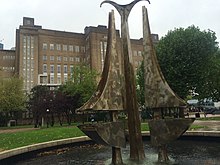
Establishment of the Aston Science Park and Aston University’s contribution to the city of Birmingham was fully recognised when the area was granted its own postal address “The Aston Triangle” in 1984, emphasising the campus as an official district of Birmingham. The logo of the establishment takes from the shape of the area.[21]
Since May 2011 Sir John Sunderland has been the current Chancellor of Aston University.
Aston University hosted the British Science Festival in September 2010, said to be Europe's largest public science event.
Aston University Engineering Academy
The university is a lead sponsor of Aston University Engineering Academy, a new university technical college (UTC) which opened in September 2012. The UTC is for students aged 14 to 19 wishing to pursue further study and careers in engineering, and is located at the edge of the Aston University campus.[22]
Aston Science Park
In 1983, Aston University, in partnership with Birmingham City Council and Lloyds Bank, established Birmingham Technology Ltd., which manages the Aston Science Park adjacent to the university site.
Campus
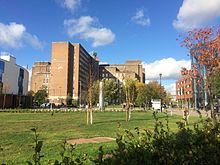
Established in 1895 as the Birmingham Municipal Technical School,[23] The university is situated on a 60-acre campus at Gosta Green, in the city centre of Birmingham, England.[24] As well as being home to over 3,000 students, the Aston University campus has the following amenities available: sports centres, swimming pool, 120 station gym, library, cafés, restaurants, pubs, shops, travel centre, hairdresser, health centre, dentist, places of worship, opticians, a bank, automated teller machines and plenty of outside space.
Aston University Library is on four floors and contains over 250,000 books, 800 current printed periodicals and has over 700 reader places. It provides online access to over 40 electronic databases and more than 3,400 electronic journals. The Library is open 24 hours a day to Aston students and staff during term time.
Around the campus there are also various open-access IT suites, offering computer and internet access 24 hours a day, seven days a week. They offer access to a range of software packages, database systems and computer-aided learning materials.
Sports
The Aston's sports facilities include a 25m swimming pool, sauna and steam room, two sports halls, 120 station Gym, weights and fitness rooms, two storey dance studio and 35 sports clubs. The campus also has two 3G floodlit sports pitches. Clubs train and compete, many in the British Universities and Colleges Sports (BUCS) Leagues. Off campus the University manages a 40 acre sports ground with floodlit pitches, pavilion for all outdoor sports.
Organisation and administration
Faculties and departments
All of the Aston University's faculties are based on one campus. They are organised into the following four schools: Template:Multicol
- School of Engineering and Applied Science
- Chemical Engineering & Applied Chemistry
- Computer Science
- Electronic Engineering
- Engineering Systems and Management
- Mathematics
- Mechanical Engineering and Design
- School of Life and Health Sciences
- Audiology
- Biology
- Biomedical Science
- Optometry
- Pharmacy
- Psychology
- School of Languages and Social Sciences*
- Modern languages & translation studies
- International relations, politics & European studies
- English language
- Sociology & public policy
- Aston Business School
- Aston Law
- Economics and Strategy
- Finance and Accounting
- Marketing Group
- Operations and Information Management Group
- Work and Organisational Psychology
Coat of arms
The university's arms were granted on 18 March 1955 by Garter, Clarenceux and Norroy and Ulster Kings of Arms to the Birmingham Corporation, for use by the former College of Technology. They were designed to show the College's connection with the City and with the teaching of technology. The arms consist of a shield and crest. The shield has two sections – the field (the main background) which is coloured blue and a chief (the broad band across the top of the shield) of silver. On the field is a diagonal line of five gold diamonds joined one to the other, similar to the first quarter of the Arms of the City of Birmingham and incorporated in the Arms of the College to show its connection with the City. This was adopted by the family of Birmingham which derived its name from the then hamlet of Birmingham, and provided the Lords of the Manor from the fourteenth to the sixteenth centuries. On the chief is depicted an open book bound in red placed between two black hammers, showing the connection of the University with technology, the book representing learning and the hammers engineering and allied trades.
The crest is also designed to stress the pursuit of knowledge. It consists of a red torch held erect by a forearm between two branches of gold laurel. Having been originally worn on the helmet of a fully armed person, the crest is always placed on the top of the helm. The method of joining the crest to the helm was usually concealed by decoration and, in the University’s arms, this is effected by the use of a wreath and a crown. The wreath is silver, red and black, these colours being taken from the shield. It is surmounted by a mural crown (resembling a wall), which is reserved in modern grants for persons and organisations connected with public corporations. The cloth mantling which hangs down from the top of the helm is the survival of the cloak which was originally worn to protect the armour, coloured in the two principal colours of the shield, blue and gold.[25]
Academic dress
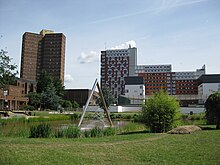
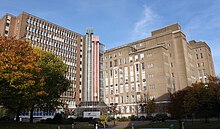
The academic dress for graduates of the University is as follows:
- Bachelor of Science, Bachelor of Engineering and Master of Engineering
- Gown: Black stuff of special design, having coat-type sleeve, narrow facings which continue round the neck and with extra wide gathers round the back
- Hood: Black stuff, modified simple shape, faced inside for three inches with University lining
- Hat: Black mortar board
- Master of Science
- Gown: Black stuff of special design, having coat-type sleeve, narrow facings which continue round the neck and with extra wide gathers round the back
- Hood: Black stuff, modified simple shape, fully lined with University lining
- Hat: Black mortar board
- Master of Philosophy
- Gown: Black stuff of special design, having coat-type sleeve, narrow facings which continue round the neck and with extra wide gathers round the back
- Hood: Blue stuff, modified simple shape, fully lined with University lining
- Hat: Black mortar board
- Doctor of Philosophy
- Gown: Claret colour cloth robe, having coat-type sleeve, narrow facings which continue round the neck and with extra wide gathers round the back
- Hood: Modified simple shape, in University Red stuff, faced inside for three inches with University lining
- Hat: Black cloth bonnet with cord and tassels of University Red
- Doctor of Science
- Gown: Same shape as for Doctor of Philosophy but in University Red, with facings on collar of University lining and gold cuffs on sleeves
- Hood: Same shape as for Doctor of Philosophy but of gold silk and fully lined with University lining
- Hat: Black velvet bonnet with cord and tassels in gold
Academic profile

Research
In the latest 2008 Research Assessment Exercise, Aston University was ranked in the top 12 in the UK in all four of its broad subject areas, with 86% of research undertaken was described as 'internationally significant'.[26] 88% of Aston academic staff were submitted for research assessment, one of the highest proportions in the UK. According to the RAE, the university's strengths include Business and Management, General Engineering, Subjects Allied to Medicine (Optometry, Biology, Pharmacy and Psychology), Languages and European Studies.[7]
Rankings
| National rankings | |
|---|---|
| Complete (2025)[27] | 27 |
| Guardian (2025)[28] | 22 |
| Times / Sunday Times (2025)[29] | =29 |
| Global rankings | |
| QS (2025)[30] | 399 |
| THE (2025)[31] | >400 |
Aston University has been ranked 47th in the world’s leading universities under the age of 50.[32] The University was also rated among the top 2% of universities in the world according to the Times Higher Education World University Rankings[33] and QS World University Rankings.[32] Graduate employers ranked Aston University 51st in the world for graduate employability (2012 QS World University Rankings)[34] and was ranked 5th out of all UK universities for the highest percentage of graduate employment record.[7]
Aston University is consistently ranked in the UK's top 20 or 30 in The Times and Complete University Guide rankings.[35] In The Complete University Guide 2010, the university was ranked 13th in the UK,[36] rated 1st for student life, and one of the UK's friendliest universities by FHM and Virgin Student.[37]
The university is highly regarded for postgraduate level success and has been consistently ranked in the top 10 for the last 15 years.[38] It is in the UK top 5 for Masters in Management Programmes and top 40 in World rankings.[38] Ranked in The World's top 100 Universities for Graduate Employer recognition (51st).[38] Out of 126 UK Universities and Colleges, it is ranked fifth for being one of the UK's Greenest Universities[38]
In the 2011 National Student Survey, Aston's overall satisfaction score was 86%, well above the UK average of 83%. Aston also has had an 'overall satisfaction' rate above the UK average for each of the seven years of the National Student Survey so far.[7] The 2011 Performance Indicators (produced by HEFCE) showed Aston had one of the lowest drop-out rates in the UK at 3.9%.[7]
Aston Business School

Founded in 1947[39] Aston Business School (ABS) is one of the largest and oldest business schools in the UK.[40][39] The school was ranked 8th in the UK and 33rd in the world by QS in 2012 and it is among the top 60 of business schools in the world to hold triple accreditation. [41] ABS was the first UK business school to be awarded the prestigious EQUIS accreditation, in 1999.[42] ABS is the first institution in the UK to be allied with Beta Gamma Sigma by establishing a BGS Collegiate Chapter. In 2006 it opened a new £22m extension including new study rooms and two new lecture theatres.[43]
The business school's Masters Management course was ranked by the Financial Times in 2012 as 5th in the UK, 33rd in Europe and 36th in the world.[44] The paper also ranked Aston Business School as 4th in the world for careers in 2011.[45] In the school's most recent Research Assessment Exercise in 2008, all research areas submitted ranked in the top 9 in the UK. 45% of the research submitted was judged to be 'excellent' or 'world-leading'.[46]
Student life
Students' Union
Aston Students' Union (formerly Guild) is a non-profit organisation set up with the aim of involving and representing the student body of Aston. The Union provides sports clubs, societies and Welfare Services, partially funded by the money accrued from the Union's commercial services.[citation needed] The Union is run by a team of permanent staff and by an elected team called the Executive who follow the rules set out in the Guild Constitution. The Union Building consists of 5 floors and is located in the centre of the Aston University Campus.
On 29 November 2006, the students voted to disaffiliate the Guild (now Union) from the National Union of Students.
Student housing


All of the accommodation in Aston University is now en-suite – 3,000 rooms in total. All campus accommodation is less than five minutes' walk from the main building, and approximately five minutes' walk from Birmingham city centre. In the 1970s, three tower blocks containing student accommodation were constructed on Aston University campus; Dalton, Lawrence and Stafford Towers. Stafford Tower has two flats per floor, each with nine single study bedrooms each flat had its own kitchen and they both shared a large bathroom. Lawrence and Dalton Towers were demolished on 8 May 2011.[47]
Another addition to Aston University student dwelling stock is the Lakeside complex on campus. Completed in August 1999, it cost £14,240,000 and has flats for approximately 650 students. The building won the Best Public Building award at the 2001 Brick Development Association Awards.
On 5 April 2007, Aston University submitted a planning application for demolition of the three 1970s towers and to replace them with new student accommodation blocks as well as apartments for tutors, retail units and administrative offices. On 5 July 2007, the application was approved and work commenced in January 2008 on phase 1. Phase 1 was completed in 2010 and Phase 2 opened in September 2013. There is also a new artificial floodlit sports pitch, chaplaincy, tesco supermarket, common rooms and accommodation offices. The demolition of the existing towers will take place for phases 2 and 3.[48] The entire scheme was completed in 2013. Upon completion there will be 2,345 bedrooms in the development alone, with 650 more ensuite rooms provided at Lakeside Residences. All the new accommodation is to be en-suite but rooms/flats will be differentiated in terms of size and facilities in order to provide students with a range of different priced rooms. Aston Student Village project will cost an estimated £215 million.[49] Phase 1 cost £57 million. Start on site date was 30 October 2008 and opened in September 2010 ready for the new term. Phase 1 buildings consist of two sections at a max height of 18 storeys with 7 and 5 ensuite bedroom apartments sharing a spacious kitchen. The buildings were named William Murdoch Residences and James Watt Residences.
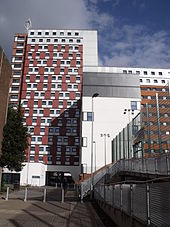
On 8 May 2011, both Dalton and Lawrence accommodation towers were demolished to make way for the above improvements. Phase 2 was built between 2011 and 2013. Once completed in Autumn 2013, they were named Harriet Martineau Residences and Mary Sturge Residences.[50] Stafford Tower was demolished on the 27th April 2014.[51]
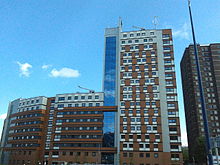
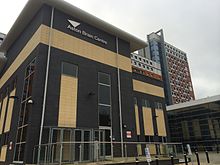

Notable people
List of Chancellors
- Lord Nelson of Stafford (May 1966 – September 1979)
- Adrian Cadbury (September 1979 – September 2004)
- Michael Bett (September 2004 – May 2011)
- John Sunderland (Since May 2011)
List of Vice-Chancellors
- Peter Venables (April 1966 - July 1969)
- Sir Joseph Pope (August 1969 - September 1979)
- Frederick W. Crawford (July 1980 - August 1996)
- Michael T. Wright (September 1996 - November 2006)
- Julia King (November 2006 – present)
Alumni
- Keith Bradley, Baron Bradley, Labour Party politician and life peer
- Rob Brighouse, Managing Director Chiltern Railways[52]
- Anthony Cheung, Secretary for Transport and Housing in Hong Kong
- Stewart Clegg, Australian sociologist
- Paul Drayson, Baron Drayson, vaccine manufacturer and Minister of State for Science, Drayson Racing Driver
- Simon D'Ujanga, State Minister for Energy in Uganda
- Veronica German, Scientist, Member of the National Assembly for Wales
- Malcolm Harbour, British politician
- Tony Hayward, Former chief executive of BP Group
- Abdollah Jassbi, President of Azad University
- Laura Jones, BBC Journalist
- Mohammad Nizar Jamaluddin, Former Chief Minister of the state of Perak
- Ravi Kant, Vice Chairman of TATA Motors, India[53]
- Ashok Kumar, Labour Party politician
- Kevin Morley, Former Managing Director of the former Rover Group
- Irfan Naseer, convicted suicide bomb plotter[54]
- Ivan Noble, BBC journalist
- Terry Pitt, Political adviser and former Member of the European Parliament
- Phil Popham, Global Operations Director for the global Jaguar Land Rover business
- John Rickard, Former Chief Economic Advisor to the British Government
- Jeff Rooker, Baron Rooker, Labour Peer
- Adam Ryland, British programmer
- Angela Beesley Starling, Co-founder of Wikia
- Susannah Streeter, BBC business news presenter
- Claire Curtis-Thomas, British Labour Party politician and former MP
- Gregor Townsend MBE, Scottish and British Lions Rugby Union Player[55]
- Kate Walsh, Television presenter
- Robert Walter, Conservative MP
- Kevin Warwick, Professor of cybernetics
- Mike Wright, Executive Director Jaguar Land Rover[52]
- Salma Yaqoob, Leader, and former vice-chairman, of Respect – The Unity Coalition
References
- ^ History
- ^ "Financial Statements 2012–2013". Aston University. Retrieved 19 April 2014.
- ^ http://www.aston.ac.uk/EasySiteWeb/GatewayLink.aspx?alId=64073
- ^ http://www.aston.ac.uk/EasySiteWeb/GatewayLink.aspx?alId=64073
- ^ http://www.aston.ac.uk/EasySiteWeb/GatewayLink.aspx?alId=64073
- ^ College optometrists.org
- ^ a b c d e Complete University Guide
- ^ http://www.theguardian.com/higher-education-network/2012/may/29/top-50-universities-under-50-2012
- ^ http://www.topuniversities.com/node/2183/ranking-details/world-university-rankings/2011
- ^ http://www.birmingham-chamber.com/Attachments/Asian-Link/Asianlink_Spring38.aspx
- ^ http://www.highfliers.co.uk/download/GMReport12.pdf
- ^ http://www.birminghampost.co.uk/news/local-news/aston-university-team-up-tech-6781285
- ^ "Aston University". Complete University Guide. Retrieved 27 April 2014.
- ^ "2013". HEFCE. 12 August 2013. Retrieved 27 April 2014.
- ^ a b c d "History and Traditions". Aston University. 2008. Archived from the original on 19 December 2008. Retrieved 31 December 2008.
{{cite web}}: Unknown parameter|deadurl=ignored (|url-status=suggested) (help) - ^ http://www.midlandsbusinessnews.co.uk/new-era-conference-aston-help-overbury/
- ^ "1950s". Aston.ac.uk. Retrieved 27 April 2014.
- ^ Foster, Andy (2007) [2005]. Birmingham. Pevsner Architectural Guides. Yale University Press. p. 195. ISBN 978-0-300-10731-9.
- ^ "History and traditions". Aston.ac.uk. Retrieved 27 April 2014.
- ^ http://www.midlandsbusinessnews.co.uk/new-era-conference-aston-help-overbury/
- ^ "1980s". Aston.ac.uk. Retrieved 27 April 2014.
- ^ "Aston University | Aston University Engineering Academy". Auea.co.uk. Retrieved 27 April 2014.
- ^ "Uni. finder > West Midlands > Aston University". HERO. Archived from the original on 12 April 2007. Retrieved 24 March 2007.
{{cite web}}: Unknown parameter|deadurl=ignored (|url-status=suggested) (help) - ^ Tarleton, Alice (1 August 2006). "Aston University". The Independent. London. Archived from the original on 26 September 2006. Retrieved 24 March 2007.
- ^ http://www.aston.ac.uk/about/history/arms/
- ^ http://www.aston.ac.uk/research/rae/
- ^ "Complete University Guide 2025". The Complete University Guide. 14 May 2024.
- ^ "Guardian University Guide 2025". The Guardian. 7 September 2024.
- ^ "Good University Guide 2025". The Times. 20 September 2024.
- ^ "QS World University Rankings 2025". Quacquarelli Symonds Ltd. 4 June 2024.
- ^ "THE World University Rankings 2025". Times Higher Education. 9 October 2024.
- ^ a b "QS World University Rankings 2013". Top Universities. 27 August 2013. Retrieved 27 April 2014.
- ^ [1][dead link]
- ^ Birmingham Chamber
- ^ "Aston University". Top Universities. 6 December 2012. Retrieved 27 April 2014.
- ^ "Aston rated among top 15 UK universities". .aston.ac.uk. Retrieved 27 April 2014.
- ^ "Undergraduate study at Aston University". Aston.ac.uk. Retrieved 20 December 2010.
- ^ a b c d ""Graduate Level" employment success". Aston.ac.uk. Archived from the original on 25 December 2010. Retrieved 20 December 2010.
{{cite web}}: Unknown parameter|deadurl=ignored (|url-status=suggested) (help) - ^ a b [2][dead link]
- ^ "The pope as a turnaround CEO". The Economist.
- ^ http://www.topmba.com/sites/qs.topmba/files/qs-global200-business-schools-report-2013_0.pdf
- ^ http://www.theguardian.com/education/2002/feb/16/students.schools
- ^ "Aston Business School, Aston University | StudyLink". Pg.studylink.co.uk. Retrieved 27 April 2014.
- ^ "Business school rankings from the Financial Times - Aston Business School". Rankings.ft.com. Retrieved 27 April 2014.
- ^ "Aston Business School is 4th in the world for careers". .aston.ac.uk. 19 September 2011. Retrieved 27 April 2014.
- ^ http://www.aston.ac.uk/research/rae/
- ^ "BBC News - Aston University tower blocks demolished". Bbc.co.uk. 8 May 2011. Retrieved 27 April 2014.
- ^ "The construction process". Aston University. 2008. Archived from the original on 29 June 2008. Retrieved 22 December 2008.
- ^ "Campus redevelopment". Aston University. 2008. Archived from the original on 19 December 2008. Retrieved 22 December 2008.
{{cite web}}: Unknown parameter|deadurl=ignored (|url-status=suggested) (help) - ^ [3][dead link]
- ^ "Attachment". aston.ac.uk. Retrieved 27 April 2014.
- ^ a b "Business Directors join Advisory Board". .aston.ac.uk. 5 March 2013. Retrieved 27 April 2014.
- ^ "Ravi Kant - Forbes". People.forbes.com. 18 April 2012. Retrieved 27 April 2014.
- ^ Laville, Sandra (21 February 2013). "Birmingham terror plotters' profiles". The Guardian. London.
- ^ "Aston University, Birmingham - A-Z Unis & Colleges - Getting Into University". The Independent. 6 June 2013. Retrieved 27 April 2014.
